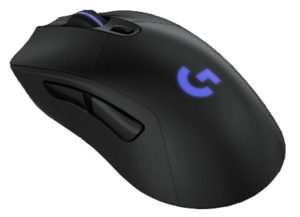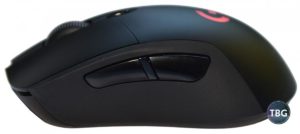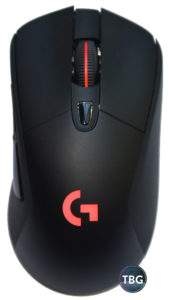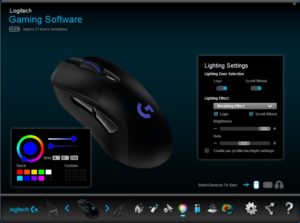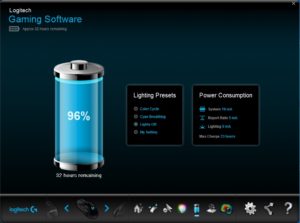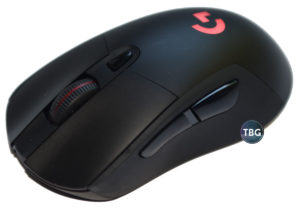Logitech G403 Prodigy Wireless Gaming Mouse Review
Pros
Cons
Rating
Introduction
Here at TBG, we’ve tested lots of mice. In fact, we’ve tested a lot of Logitech mice. That includes the G502 Proteus Core, which we reviewed alongside the venerable Logitech G5 and G9x, the G602 Wireless Gaming Mouse, the first mouse review we published, and the G502 Proteus Spectrum, which won our big gaming peripherals shootout. In that comparison review, we sampled a number of other manufacturers’ mice, including models from Corsair, Razer, and EVGA, so we have a good sense of what’s out there.
Through all of this testing, the one thing we haven’t found is a wireless mouse that can perform as well as a wired mouse. Sure, the Logitech G602 was a very nice mouse, but when it came to fast-paced gaming, it just couldn’t keep up with Logitech’s wired models. And few other manufacturers have even ventured down this road, with Razer being the only major brand currently offering a wireless mouse, the $150 Mamba. And while we haven’t tried it, we’re betting it’s not a top performer, because even Razer doesn’t market it very aggressively, and Razer markets its best products very aggressively.
So, what’s a gamer to do? Make do with a laggy, heavy wireless mouse, or choose a high-performance wired mouse that may occasionally get stuck amongst the clutter on your desk? Well, Logitech decided it was time to take another shot at ending the compromise that every gamer faced, starting at the top, with the $150 G900 Chaos Spectrum. It debuted in April 2016 at the $150 pricepoint previously occupied only by Razer’s Mamba, and while it received great reviews, it wasn’t for everyone. For starters, it’s one seriously expensive, and in addition, its ambidextrous design might have pleased lefties, but it wasn’t actually ideal for anyone.
And that’s where the new G403 fits in. Using the same sensor and high-performance wireless system as the G900, the G403 takes the price down a notch and the comfort up a notch. Could it be The One? Read on to find out!
We’d like to extend a special thank you to Logitech for providing us with a review sample of the Logitech G403 Prodigy Wireless Gaming Mouse.
Description and Features
Clearly taking cues from its rival Razer, Logitech has abandoned the aggressive, cyber-punk look of the G402, G502, and G900, and focused on the basics: a shape that fits the hand, and a minimum of buttons. Up until we tried out the G403, the Razer Deathadder was the most comfortable mouse we’d tested. As we’ll discuss on the next page, we think we’ve found a new favorite. The G403 is a near copy of the Deathadder, yet improves upon it in subtle ways that make a big difference. First, it has a rounded right-front edge, which follows the natural contours of the fingers as they rest on the mouse, unlike the Deathadder which has symmetric edges. Secondly, it’s a bit flatter, which is best for a mouse this size, given that it’s really too small for a true palm grip.
Logitech makes a big deal of the G403’s Pixart PMW3366 optical sensor, capable of 12,000dpi, and previously used in the range-topping G900. Given that we quickly lose control of a mouse above about 2400dpi, we’ve never been all that moved by high DPI numbers, but the sensor certainly seems to be quite responsive. Aiding it is the advanced wireless transmitter system originally developed for the G900. It’s so good that it will beat many competitors’ wired mice in terms of latency, a bold claim we verified for ourselves using Logitech’s latency measurement device demonstrated at PAX West 2016. Ultimately, what really matters is real-world performance, though, and we’ll discuss that more on the next page.
In terms of dimensions, the G403 is 124 mm long, 68mm wide, and 43mm tall, and weighs a scant 107.2g, amazingly-light for a wireless mouse. By comparison, our wired G502 is 121g, and our wireless G602 with two AA batteries weighs in at a portly 165g, which makes it a lot more sluggish in the hand. The low weight of the G403 also means that it glides smoothly, and Logitech has endowed it with ample glide pads that will have no trouble keeping it level and moving gracefully. We actually found it to be too light, and installed the included 10g weight to give the mouse a bit more heft.
While it doesn’t have nearly as many buttons as some of its stablemates, at least the G403 has the one button that Razer has amazingly never added to its Deathadder: DPI adjustment. Logitech has used a simple one-button affair here, mounted right on top, rather than a side-mounted up/down button pair as on its other gaming mice, but we think that’s a reasonable compromise given the clean aesthetics it provides. It’s also incredibly-easy to find mid-battle (or mid-spreadsheet, as the case may be). You also get a left and right button, of course, along with a third scroll-wheel button (but not the G502’s hyper-fast scroll, unfortunately). As for the critical forward/back thumb buttons, they are perfectly sized and placed, proving far superior to those on previous Logitech mice, which have often featured a number of very small side buttons. If you’re a MOBA or MMO player, you might find the G403 lacking in this area, but for everyone else, it’s really ideal.
As with most new mice, the G403 offers RGB color effects. This will probably be quite attractive to certain users, while others will find it less than compelling. In reality, we think Logitech is playing catch up in this regard. Logitech seems to have tacked the lighting features onto the G403, rather than fully integrated them into the shell of the mouse as have competitors like Razer, Roccat, and Corsair on their high-end offerings. If you want a mouse that doubles as a light show, look elsewhere. Logitech’s lighting is tasteful, but relatively subtle, and we found it was a bit uneven, with greens and reds showing more brightly than blues. At least its Logitech Gaming Software is top notch, offering an attractive interface, simple navigation, and integration with other Logitech peripherals (including headsets and keyboards), allowing you to sync the lighting effects between all your Logitech gear.
Alas, all the G403’s fancy electronics push its lightweight battery to the limit, so you’ll quickly find yourself needing a charge. Thankfully, Logitech includes a braided cable with a micro-USB attachment, which can be plugged directly into the mouse to turn it into a wired mouse, allowing you to keep working while the battery charges. Not surprisingly, we found that the stiff cable took away the freedom of movement that makes the G403 feel so great, and because the non-flexible charging adapter is fairly bulky, the mouse in wired mode is a bit more awkward to use than a typical wired mouse. The Logitech Gaming Software indicated that the G403 would run 33 hours with no RGB effects, and 22 hours with the LEDs constantly lit (translating to a 50% reduction in run time to keep the lights on). Based on our testing, we think that’s quite accurate. While it’s nice that Logitech is offering RGB lighting on a wireless mouse, it clearly comes at a cost. Power users may in fact want to turn the RGB effects off to gain more run time. Note that the battery actually charges very quickly, meaning we were always able to switch back to wireless mode after a few hours.
One minor issue we should note is that both of our pre-release samples failed to properly store custom color profiles. For instance, if we set it to the “Breathing Effect” as shown in the screenshot above, which looks nice and uses half the battery power of constantly-lit LEDs, our mouse would revert to RGB color cycling upon sleeping, shutting down, or restarting. It also kept cycling for about 10 minutes after sleeping or shutting down, a serious waste of battery power. We’re assuming Logitech can fix these flaws in retail models.
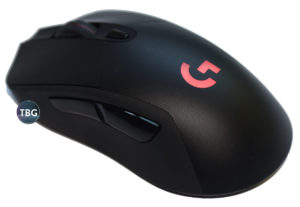
Performance
We tested the G403 Prodigy Wireless over the course of several weeks, using it for word processing, Photoshop, browsing the web, and of course gaming. No matter what we challenged it with, it never failed to impress. We never felt it skip, lag, or drop out, and every click registered instantly. We should note that during most of our testing, we used the included USB-to-micro-USB adapter to attach the G403’s receiver directly to the charging cable, and placed this receiver within inches of the mouse. Given that you’ll need that cable nearby for regular charging anyway, we’d recommend most users simply keep the receiver there the rest of the time, rather than plug it into the back of your PC, which could lead to some wireless interference. During our limited testing with the mouse two to three feet from the receiver, however, it worked perfectly.
And how about comfort? Realistically speaking, no one shape can fit every hand, and certainly left-handers are going to want to consider an ambidextrous mouse like the G900 or bargain-priced G303. That being said, the G403 is the most comfortable mouse we’ve ever used, bar none. It just fits, period, with a profile that allows you to get a solid grip without straining your hand. The top has a contoured shape for your index and middle finger, while the right side is easy to wrap your ring and pinky fingers around. The one minor blemish in terms of ergonomics is the lack of a thumb rest, which has been a staple of many of Logitech’s past mice, be they gaming or productivity models. Having a thumb rest doesn’t necessarily make a mouse more comfortable, though, as some may find it confining. We tend to like having a thumb rest, but we quickly became accustomed to the G403’s lack of one. Helping out in that regard is the slightly-tacky rubberized texture used on the sides of the mouse, inviting the user to actively hold on to the mouse rather than use a lazy grip that would let your thumb drag on the mousing surface.
As we mentioned on the previous page, the G403’s impressive performance comes at a cost: battery life. To make the G403 as light as it is, a relatively-small battery was required. To make it as fast as it is, a powerful sensor and wireless transmitter were needed. In the screenshot below, you can see the power use of these components as calculated by the Logitech’s software-based battery gauge:
Overall, we think the tradeoff is worth it, but for PC users who need a set-and-forget solution, a wired mouse is really a better option. We’re thinking of office workers here, for whom the G403’s regular recharging requirements could be inconvenient, or professional gamers, who will likely prefer to know that their mouse is always “in the game.” For these users, Logitech is offering the G403 Wired Gaming Mouse, marking the first time that Logitech has offered the same mouse in both wired and wireless versions. Our hunch is that Logitech knew the G403’s shape and sensor performance would be appreciated by a lot of users, so rather than release two distinct designs, it simply put its best foot forward with one universal design.
Conclusion
In the introduction to this review, we asked if this could be “The One”, the wireless mouse that gamers have been waiting for since the dawn of the PC gaming era. Well, from our point of view, it is. It’s already replaced the duo of a G502 and G602 on our work/gaming desk, and it could also replace the various other gaming mice we have on our other test benches, including the Razer Deathadder and the Corsair M65 Pro. And remember, all but one of those is a wired mouse. If Logitech’s goal was to offer the best performing, most comfortable gaming mouse on the market, it has most definitely succeeded. The G403’s only weakness is its painfully-average RGB lighting system, and if you care about these sorts of things, you’ll probably need to go with a wired mouse from one of Logitech’s competitors. But if wireless gaming performance is your #1 priority, the G403 Wireless is most definitely The One!
The Logitech G403 Prodigy Wireless Gaming Mouse is available from Amazon for $99.99 shipped, as our most recent update. It has absolutely no competition at any price, making it an exceptional value. The wired version of the Logitech G403 Prodigy comes in at $69.99 shipped from Amazon. This mouse must compete directly with a number of strong contenders, not least of which is Logitech’s own feature-rich G502 Proteus Spectrum, which is currently $59.99 shipped from Amazon. We think the G403’s comfort makes it the winner overall, but those looking for lots of buttons and a fancy scroll wheel will likely want to stick with the popular G502.
To see all of our top picks in every peripheral category, don’t miss our Peripherals Buyer’s Guide, updated quarterly!


